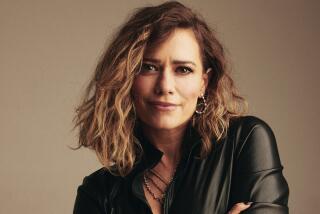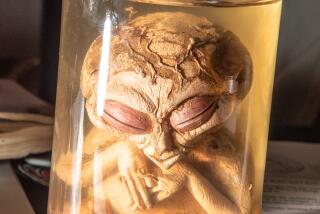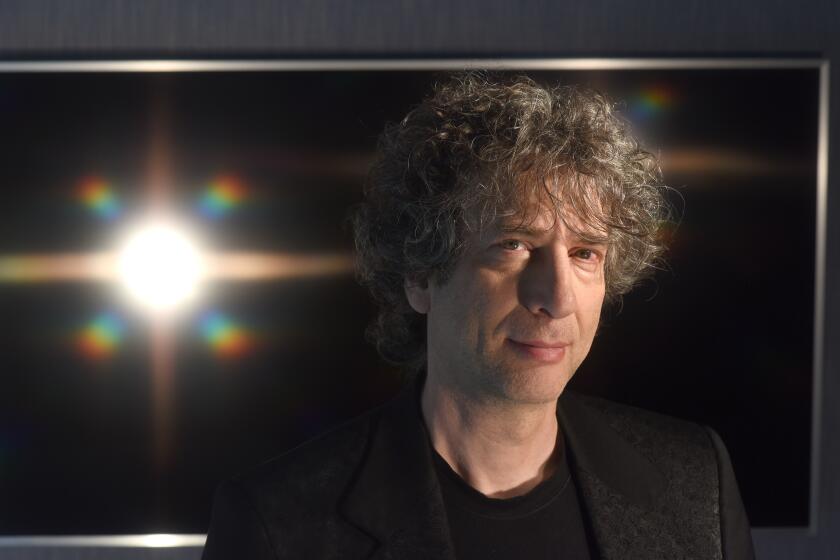A home unlike all others
- Share via
Earlier this summer, almost 100 psychedelic music fans, subculture aficionados, students of the occult and local literati climbed the flower-petal-strewn steps of publisher couple Jodi Wille and Adam Parfrey’s Silver Lake home for a salon celebrating the upcoming publication of “The Source: The Untold Story of Father Yod, YaHoWa 13 and the Source Family” (Process), the definitive history of a mystical cult that thrived in Los Angeles between 1970 and 1974. The book’s author, Isis Aquarian (formerly Charlene Peters), had flown in from Hawaii, and Family members Omne, Magus, Electra and Orbit, all of whom are now in their 50s and 60s, had also come to share stories.
During a Q&A; session, they good-naturedly addressed whether they’d been brainwashed (“Absolutely!” said Orbit, who now goes by David) and answered questions about Dionysm, the form of tantric sex they’d practiced.
“I’m ready to join right now!” announced one attendee, no doubt echoing the sentiments of many who wistfully longed for a time when Utopia was, if not entirely feasible, at least on the agenda.
Imagine your fantasy commune, the one you’d find only in the movies, where everyone is young and beautiful; the clothes are fabulous; the leader benign; and home is a mansion in the Hollywood Hills. Chances are it probably looks a lot like the Source Family, whose 140 members “dropped out” right in the middle of Los Angeles. Led by a bearded, hunky, 6-foot-3 former war hero who called himself Father Yod and, later, YaHoWha, this vibrant group of men and women embarked on a wild social experiment, turning all their material possessions over to the group and supporting themselves serving gourmet vegetarian cuisine at their popular Sunset Strip restaurant, the Source. Living communally in a Los Feliz mansion owned by the Chandler family (former owners of this newspaper) and then in a house built by Catherine Deneuve, many of them formed polyamorous relationships; not surprisingly, the most extreme example was Father Yod, who took 14 “spiritual wives.”
Notwithstanding the group’s visible presence in Hollywood (brothers and sisters could often be seen strolling en masse down Sunset, Atlantean robes and hair a-flowing), extensive media coverage, and the catalog of music they recorded as YaHoWa 13 -- legendary among connoisseurs of psychedelic rock -- the Source story has remained untold for 30 years. This is partly because of a vow of secrecy taken by all members, but more likely it’s a reflection of their confusion and even shame about the communal experience, for which American society gave them only one place to file: in the freaky hippie bin.
Wille, who edited the book and is also at work on a Source Family documentary, believes cults are due for a second look. “They have yet to be reassessed since the anti-cult backlash of the ‘70s,” she noted. “What people of our generation don’t realize is that our impressions have been formed by the images that have been repeated in the mass media.” Indeed, who can link California and cult without envisioning Charles Manson? Wille admitted that even her perceptions were affected by this conditioning when she first saw pictures of the Source Family in the late ‘90s. “I thought, ‘cool, creepy cult!’ Because that was my mind-set back then.”
Despite the trend toward collective living among senior citizens today, to say nothing of the mainstreaming of organic food and alternative medical practices, both integral to the Source way of life, these negative images and ideas continue to be upheld in books such as T.C. Boyle’s “Drop City” and the memoir “My Life in Orange” by Tim Guest, or two new documentaries: “Join Us” (by “Dig!” director Ondi Timoner) and “Children of God.” Of course, those perspectives remain valid, but what about the stories that don’t detail abuse?
According to Erik Davis, author of “The Visionary State: A Journey Through California’s Spiritual Landscape,” who also wrote “The Source’s” introduction, “For the most part, small sectarian religious movements don’t leave any mark on the larger culture unless they fulfill the archetype and something really bad happens. Everybody knows about the Branch Davidians, Heaven’s Gate, the Manson Family, Jim Jones. But there are myriad groups of that size or even larger that are actually influential on the culture in small ways.
“There isn’t really a model of a successful, creative, alternative religious sect in the general mind-set. It doesn’t exist as a category, so that when there is one, it’s hard to figure out where to put it. It has to be kitsch, at best, or it has to be kind of dangerous.”
Fortunately, unlike so many of these groups that formed in the wake of the ‘60s and disbanded without a trace, the Source Family had a dedicated Keeper of the Records, Isis Aquarian, who several years ago decided it was time to “come out of the Source closet.” Packaged with a CD of music and interviews, “The Source” is an intimate history narrated by Isis and peppered with the recollections of Electricity, Djin, Sunflower, Damian, Lotus, Goddess and many other exotically named participants.
For Wille, the goal was not to put a rosy spin on the tale but to include diverse viewpoints, which she felt was essential to the Source’s historical relevance. “There are voices of dissent in this book, and to me that’s what makes it a very rich document of the time period. You have this deeply personal voice guiding you through it, but [Isis] has the openness to allow people with different opinions to express themselves.”
Sex, drugs, and. . . you know
Most Family members came in through the restaurant, grooving on the rainbow-hued salads and the beautiful people and eventually joining in the 4 a.m. meditations (enhanced by one toke of “sacred herb”) and the daily lectures on everything from Sikhism to Freemasonry to Buckminster Fuller. Father Yod’s primary message was the idea that the individual can attain God consciousness in this lifetime. For many members, he was both Father and God.
“Part of the beauty of Father Yod’s teachings,” Wille said, “was that he did take the prevalent energies of the era -- marijuana, sex and rock ‘n’ roll -- and he made them sacred. He taught his children to find the sacredness in everything, and I’m not saying that they were always thinking sacred thoughts, but that was the aim: to think of every human being and the food on your plate as sacred. And that’s honorable to me.”
Davis, while acknowledging his “kundalini opportunism,” categorized Father Yod as what the religious scholar Robert Ellwood calls a magus -- “a Shaman-in-civilization.” Ellwood, speaking from his home in Ojai, noted that this was “an important part of the whole ‘60s approach -- the idea that the best kind of spirituality is communicated through an individual. . . . Institutional religion is more about the organization, but real spirituality comes from the individual.”
Isis, a former beauty queen who left a glamorous life and a fiancé to join the Family in her late 20s, remains a devoted disciple. Although she knew Father Yod when he was still called Jim Baker, she accepted him immediately in his new incarnation and became his oldest wife. “I knew instantly that he was my spiritual guru,” she recalled. “I never looked back. And this is something that each one of us felt. There was never any question that this was our destiny.”
The sect’s Hollywood beginnings make for a juicy read, with Father Yod at the wheel of a white Rolls-Royce and Julie Christie, Warren Beatty and John Lennon making regular appearances at the restaurant. The so-called Mother House was like a hippie Playboy mansion, where friends came to Sunday socials to listen to Father speak. The much smaller Father House was also a social hub, receiving visitors from the Seattle commune Love Israel.
Thanks to the rigorous sex practices, 51 Source Family babies were born -- all delivered naturally at home, in keeping with their distrust of traditional medicine. In the end, this would lead to the group’s leaving Los Angeles, when a baby severely infected with staph had to be taken to the hospital, alerting the authorities to perhaps other unorthodox goings on in the three-bedroom house where more than 100 slept, many in stacked pods in the yard. Tuning in to apocalyptic visions, Father Yod initiated a move to Hawaii, where in 1975 he died after a hang gliding accident, eventually breaking apart the Family.
Said Isis, “We are just now starting the healing process.” In the wake of their leader’s death, “a lot of people left and shut the door behind them, and it’s just now becoming safe for them to talk about it.”
The book has been a crucial part of that healing process, honestly exploring the struggles of Father Yod’s wife Robin, who married him as Jim Baker and, in Isis’ words, “didn’t sign up for any of it.” It also gave Paralda a forum to address “Jim, Father Yod, YaHoWha” in an open letter. The onetime student of the Maharishi Mahesh Yogi accused this “charismatic father figure” of seducing her and ultimately asked for the ability to forgive him and herself.
Rather than closing a chapter, however, the experience of revisiting the past has inspired Isis and some of the others to “continue this adventure.” Seven have bought property on the Big Island in Hawaii, with the plan to form a co-housing community, supporting themselves with a health spa and, yes, a restaurant. Given the Family’s vast scope of knowledge about nutrition and the healing arts, and even home births and deaths, both much more widely accepted today, it actually makes perfect sense. Isis said excitedly, “We could do some outrageous stuff still.”
More to Read
Sign up for our Book Club newsletter
Get the latest news, events and more from the Los Angeles Times Book Club, and help us get L.A. reading and talking.
You may occasionally receive promotional content from the Los Angeles Times.









